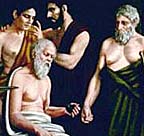 "The first medieval reference to anaesthesia was in the fourth century, in the writings of Hilary of Poitiers. Hilary was Bishop of Poitiers, exiled to the Orient in 356 A. D. by the Emperor Constantius. It was in the Orient that he first wrote about anaesthesia. He described drugs that lulled the soul to sleep. In 359 A. D Hilary returned to Poitiers. Apuleius, a compiler of medical literature in the fifth century wrote '...if anyone is to have a limb mutilated, burnt, or sawn, he may drink a half ounce with wine, and whilst he sleeps the member may be cut off without any pain or sense."
"The first medieval reference to anaesthesia was in the fourth century, in the writings of Hilary of Poitiers. Hilary was Bishop of Poitiers, exiled to the Orient in 356 A. D. by the Emperor Constantius. It was in the Orient that he first wrote about anaesthesia. He described drugs that lulled the soul to sleep. In 359 A. D Hilary returned to Poitiers. Apuleius, a compiler of medical literature in the fifth century wrote '...if anyone is to have a limb mutilated, burnt, or sawn, he may drink a half ounce with wine, and whilst he sleeps the member may be cut off without any pain or sense."
I also did not realize that hemlock was used in ancient times as an anesthetic (as well as a poison). However, this article pointed out the problems the ancients had with trying to regulate the dose and the sometimes dire consequences.
"Hemlock caused as many problems as it relieved. This is because the level of hemlock contained in leaves varied according to weather, climate, the age of harvesting of the plant, the conditions in which it was grown etc., and so the quantity of hemlock that was used in potions was not constant. This led to accidental overdoses and death."
No comments:
Post a Comment